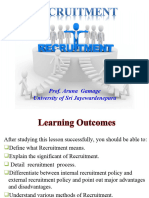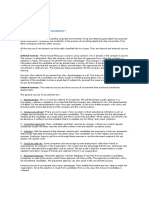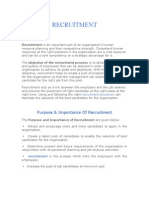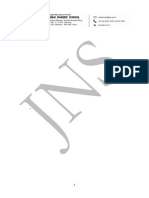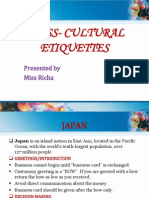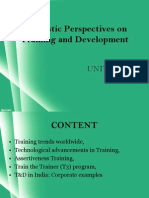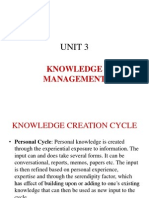HRM Unit 3
HRM Unit 3
Uploaded by
richa928Copyright:
Available Formats
HRM Unit 3
HRM Unit 3
Uploaded by
richa928Original Description:
Original Title
Copyright
Available Formats
Share this document
Did you find this document useful?
Is this content inappropriate?
Copyright:
Available Formats
HRM Unit 3
HRM Unit 3
Uploaded by
richa928Copyright:
Available Formats
RECRUITMENT & SELECTION
Concept of Recruitment & Selection, Process of Recruitment & Selection, Sources of Recruitment : Internal & External, Sources of Testing: Aptitude test, Personality test, Simulation Exercises, Interview, Application Blank, Induction Programme
Organizational activities that provide a pool of applicants for the purpose of filling job openings. It is a process of searching for prospective employees .
Stimulating & Encouraging them to apply for jobs in the org.
Every organisation has the option of choosing the candidates for its recruitment processes from two kinds of sources: internal and external sources. The sources within the organisation itself (like transfer of employees from one department to other, promotions) to fill a position are known as the internal sources of recruitment. Recruitment of candidates from all the other sources (like outsourcing agencies etc.) are known as the external sources of recruitment
Internal sources of recruitment: Internal sources of recruitment refer to obtaining people for job from inside the company. There are different methods of internal recruitment Promotion :- Companies can give promotion to existing employees. This method of recruitment saves a lot of time, money and efforts because the company does not have to train the existing employee. Since the employee has already worked with the company. He is familiar with the working culture and working style. It is a method of encouraging efficient workers.
Departmental examination:- This method is used by government departments to select employees for higher level posts. The advertisement is put up on the notice board of the department. People who are interested must send their application to the HR department and appear for the exam. Successful candidates are given the higher level job. The method ensures proper selection and impartiality. Transfer :- Many companies adopt transfer as a method of recruitment. The idea is to select talented personnel from other branches of the company and transfer them to branches where there is shortage of people.
Retirement :- Many companies call back personnel who have already retired from the organization. This is a temporary measure. The method is beneficial because it gives a sense of pride to the retired when he is called back and helps the organization to reduce recruitment selection and training cost.
Internal advertisement :- In this method vacancies in a particular branch are advertised in the notice board. People who are interested are asked to apply for the job. The method helps in obtaining people who are ready to shift to another branch of the same company and it is also beneficial to people who want to shift to another branch.
Employee recommendation :- In this method employees are asked to recommend people for jobs. Since the employee is aware of the working conditions inside the company he will suggest people who can adjust to the situation. The company is benefited because it will obtain.
Advantages Of Internal Recruitment
1. 2. 3.
Disadvantages Of Internal Recruitment There is no opportunity to get new talent in this method. 2. The method involves selecting people from those available in the company so there is limited scope for selection. 3. There are chances of biased and partiality. 4. Chances of employee discontent are very high.
1.
4.
Internal methods are time saving. No separate induction program is required. The method increases loyalty and reduces labour turnover. This method is less expensive.
External methods/sources of recruitment: External sources of recruitment refer to methods of recruitment to obtain people from outside the company. These methods are: Management consultant :- Management consultant helps the company by providing them with managerial personnel, when the company is on the look out for entry level management trainees and middle level managers. They generally approach management consultants
Employment agencies :- Companies may give a contract to employment agencies that search, interview and obtain the required number of people. The method can be used to obtain lower level and middle level staff. Campus recruitment :- When companies are in search of fresh graduates or new talent they opt for campus recruitment. Companies approach colleges, management, technical institutes, make a presentation about the company and the job and invite applications. Interested candidates who have applied are made to go through a series of selection test and interview before final selection.
News paper advertisement :- This is one of the oldest and most popular methods of recruitment. Advertisements for the job are given in leading news papers; the details of the job and salary are also mentioned. Candidates are given a contact address where their applications must be sent and are asked to send their applications within a specified time limit. The method has maximum reach and most preferred among all other methods of recruitment. Internet advertisement :- With increasing importance to internet, companies and candidates have started using the internet as medium of advertisement and search for jobs. There are various job sites like naukri.com and monster.com etc. candidates can also post their profiles on these sites. This method is growing in popularity.
Walk in interview :- Another method of recruitment which is gaining importance is the walk in interview method. An advertisement about the location and time of walk in interview is given in the news paper. Candidates require to directly appearing for the interview and have to bring a copy of their C.V. with them. This method is very popular among B.P.O and call centers.
Advantages Of Internal Recruitment
Disadvantages Of Internal Recruitment
1.
There is influx of new talent in the method. 2. The method encourages more and more competition. 3. There is lesser chance of partiality through this method. 4. If options like campus recruitment have been exercised we get a chance to employ fresh graduates, thus increasing employment.
1.
2. 3.
The method is costly because it involves recruitment cost, selection, training cost. The method is time consuming. The method reduces loyalty to the organization.
Identifying the vacancy: The recruitment process begins with the human resource department receiving requisitions for recruitment from any department of the company. These contain:
Posts to be filled Number of persons Duties to be performed Qualifications required
Preparing the job description and person specification. Locating and developing the sources of required number and type of employees (Advertising etc).
Short-listing and identifying the prospective employee with required characteristics.
Arranging the interviews with the selected candidates.
Conducting the interview and decision making
Selection Once the potential applicants are identified, the next step is to evaluate their qualification , qualities,experiences, capabilities,etc..&make the selection. It is the process of offering jobs to the desired applicants.
Selection means choosing a few from those who apply, It is picking up of applicants or candidates with requisite qualifications and qualities to fill jobs in the organization.
The process of selection is different in different companies; however a general procedure of selection can be framed.
Reception Of Applications-
On the basis of job description and advertisement posted applications are invited for the vacant position.
Preliminary interviewIt is basically background interview, here very general questions are asked regarding their qualifications, family background etc
Application blank/form :Application blank is the application form to be filled by the candidate when he applies for a job in the company. The application blank collects information consisting of 4 parts- 1) Personal details 2) Educational details 3) Work experience 4) Family background.
Written test :The applications which have been received are screened by the HR department and those applications which are incomplete are rejected. The other candidates are called for the written test. Arrangement for the written test is looked after the HR department i.e. question papers, answer papers, examination centers and hall tickets etc.
Interview :Candidates who have successfully cleared the test are called for an interview. The entire responsibility for conducting the interview lies with the HR department i.e. they look after the panel of interviewers, refreshments, informing candidates etc. 6. Medical examination :The candidates who have successfully cleared the interview are asked to take a medical exam. This medical exam may be conducted by the organization itself (army). The organization may have a tie up with the hospital or the candidate may be asked to get a certificate from his family doctor.
Initial job offer :Candidates who successfully clear the medical exam are given an initial job offer by the company stating the details regarding salary, terms of employment, employment bond if any etc. The candidate is given some time to think over the offer and to accept or reject. 8. Acceptance/ rejection :Candidates who are happy with the offer send their acceptance within a specified time limit to show that they are ready to work with the company. 9. Letter of appointment/final job offer :Candidates who send their acceptance are given the letter of appointment. The letter will state the name of the job. The salary and other benefits, number of medical leaves and casual leaves, details of employment bond if any etc. It will also state the date on which the employee is required to start duty in the company.
Aptitude and ability tests are designed to assess your logical reasoning or thinking performance. They consist of multiple choice questions and are administered under exam conditions. They are strictly timed and a typical test might allow 30 minutes for 30 or so questions.
You may be asked to answer the questions either on paper or online. The advantages of online testing include immediate availability of results and the fact that the test can be taken at employment agency premises or even at home. This makes online testing particularly suitable for initial screening as it is obviously very cost-effective.
Aptitude and ability tests can be classified as speed tests or power tests. In speed tests the questions are relatively straightforward and the test is concerned with how many questions you can answer correctly in the allotted time. Speed tests tend to be used in selection at the administrative and clerical level. A power test on the other hand will present a smaller number of more complex questions. Power tests tend to be used more at the professional or managerial level
There are at least 5000 aptitude and ability tests on the market. Some of them contain only one type of question (for example, verbal ability, numeric reasoning ability etc) while others are made up of different types of question.
First Things First The first thing to do is to determine which type of questions you are going to be asked. Don't waste time practicing questions that won't appear in the actual test. Types of question can be classified as follows: Verbal Ability - Includes spelling, grammar, ability to understand analogies and follow detailed written instructions. These questions appear in most general aptitude tests because employers usually want to know how well you can communicate. Numeric Ability - Includes basic arithmetic, number sequences and simple mathematics. In management level tests you will often be presented with charts and graphs that need to be interpreted. These questions appear in most general aptitude tests because employers usually want some indication of your ability to use numbers even if this is not a major part of the job.
Mechanical reasoning- - Designed to assess your knowledge of physical and mechanical principles. Mechanical reasoning questions are used to select for a wide range of jobs including the military (Armed Services Vocational Aptitude Battery), police forces, fire services, as well as many craft, technical and engineering occupations. Fault Diagnosis - These tests are used to select technical personnel who need to be able to find and repair faults in electronic and mechanical systems. As modern equipment of all types becomes more dependent on electronic control systems (and arguably more complex) the ability to approach problems logically in order to find the cause of the fault is increasingly important.
Data Checking - Measure how quickly and accurately errors can be detected in data and are used to select candidates for clerical and data input jobs. Work Sample Involves a sample of the work that you will be expected do. These types of test can be very broad ranging. They may involve exercises using a word processor or spreadsheet if the job is administrative or they may include giving a presentation or in-tray exercises if the job is management or supervisory level
Don't Waste Time Spend your preparation time wisely. Most people find themselves with only one or two weeks to prepare for aptitude tests - don't worry, this is enough time provided that you are systematic. You must find out what type of questions you are going to face even if this means asking. Use the information on this website to get an idea of the different types of questions. Download and look at a sample paper for each type of question you are expecting to face. Go through one paper of each type and see how you get on. Decide on a practice strategy. Practice one paper a day right up until the actual test. If in Doubt - Ask! If you are unsure what types of question to expect then ask the human resources people at the organization you are applying to. This will not count against you in any way and they should be only too happy to tell you. You have a right to prepare yourself for any tests you are asked to sit.
Personality tests are used to help determine how your personality relates to your career choices. Here are a selection of general personality tests and career tests which assess your aptitude for different careers
A self-report inventory is a type of psychological test often used in personality assessment. This type of test is often presented in a paper-and-pencil format or may even be administered on a computer. A typical self report inventory presents a number of questions or statements that may or may not describe certain qualities or characteristics of the test subject.
Chances are good that you have taken a selfreport inventory at some time the past. Such questionnaires are often seen in doctors offices, in on-line personality tests and in market research surveys. This type of survey can be used to look at your current behaviors, past behaviors and possible behaviors in hypothetical situations.
The 16 Personality Factor Questionnaire Another well known example of a self-report inventory is the questionnaire developed by Raymond Cattell to assess individuals based on his trait theory of personality. This test is used to generate personality profile of the individual and is often used to evaluate employees and to help people select a career.
Strengths and Weaknesses of Self-Report Inventories Self-report inventories are often an good solution when researchers need to administer a large number of tests in relatively short space of time. Many self report inventories can be completed very quickly, often in as little as 15 minutes. This type of questionnaire is an affordable option for researchers faced with tight budgets. Another strength is that the results of self report inventories are generally much more reliable and valid than projective tests. Scoring of the tests a standardized and based on norms that have been previously established.
An unstructured, indirect form of questioning that encourages respondents to project their underlying motivations, beliefs, attitudes or feelings regarding the issues of concern. In projective techniques, respondents are asked to interpret the behavior of others. In interpreting the behavior of others, respondents indirectly project their own motivations, beliefs, attitudes, or feelings into the situation.
In word association, respondents are presented with a list of words, one at a time and asked to respond to each with the first word that comes to mind.
In Sentence completion, respondents are given incomplete sentences and asked to complete them. Generally, they are asked to use the first word or phrase that comes to mind.
In story completion, respondents are given part of a story enough to direct attention to a particular topic but not to hint at the ending. They are required to give the conclusion in their own words.
Personality Test are the tests which discover about the self confidence , ambition , decisiveness , patience , judgment,emotional reaction Tests are of the following types : -Aptitude Test are the tests in which the attention is paid on reasoning , learning - Mental or Intelligence tests(to measure the IQ of individual) - Movement test(to measure the learning capacity for the mechanical work like for mechanics and maintenance workers) - Interest Test (well designed questionnaires are used to asses the likes and dislikes of the individuals
Interview is defined as a face to face information between two persons for a particular purpose Objectives of conducting the interview : 1 To verify the information obtained earlier 2 To judge the candidate`s qualifications & characteristics so as to decide to select or reject 3 To give the candidate essential facts about the job and the company to enable him to decide about the company 4 Interview helps to judge about the physical , mental , social make up of the candidate
Informal interview may take place anywhere as it is not planned and is used when the staff is required urgently Formal interview is preplanned in advance (venue , time , panel of interviewers )and is held in an formal atmosphere Structured interview is fully planned to a high degree of accuracy and precision. It is based on the assumption that every small detail should be worked out in advance In this the time allowed to each candidate is fixed and the questions to be asked are predecided Also known as directed or guided interview and also these types of interviews help to minimize personal biasness
Group interview are those in which the groups are interviewed rather than individuals Panel or Board interview is that in which there is a group of interviewers who ask questions on a random basis Stress interview is to see how a candidate behaves under difficult situations
Induction :-Define induction :Induction can be defined as a process of introducing the employee who is newly elected to the organization. When an employee is given a letter of appointment he joins the company on duty. The very first thing that the company does is, introduces the new employee to the organization and people working there. An induction program may be conducted at a particular center for all employees or at different places (branches of the company) for different employees.
INDUCTION PROGRAM Induction Programs are designed to create just right impression about the company, its mission, culture and policies among new recruits it also give the idea about company. A well-planned carefully designed Induction Program will go a long way in clearing a path of fresh employee. Induction Program for employee helps them develop a bond & feeling of oneness which make leaving the organization difficult. Its more of a family. For freshers induction program tell that about workplace, some work related tips because they are fresher they have no practical knowledge so they also get some comfort . Why its necessary ? When any employee enter in a organization he normally feels blank about the company so if we dont provide him proper Induction Program he remains blank & Whatever he / she gets the information about the company from the employees whether right or wrong he also starts thinking in a same manner. So if we provide them induction program this condition will not come. How it will help our Company? We will get motivated employees.
Induction is process meant to help the new employee to settle down quickly into the job by becoming familiar with the people, the surroundings, the job, the firm and the industry. Induction is the process of acquainting the new employees with the existing culture and practices of the new organization.
To sort out all anxiety of recruited person. To ensure the effective integration of staff. History and introduction of founders. Understand the standards and rules (written and unwritten) of the organisation. Introduction to the company/department and its personnel structure.
Employee retention. Create good impression It creates good adhesion It take less time to familiarise Less turnover ratio Increase productivity No chaos Cost reduction
You might also like
- Recruitment ReportDocument20 pagesRecruitment ReportSugandha Bhatia100% (1)
- HOWARD Pierce The Big Five Quickstart PDFDocument27 pagesHOWARD Pierce The Big Five Quickstart PDFCarlos VenturoNo ratings yet
- Recruitment NotesDocument5 pagesRecruitment NotesHarshal Desai100% (1)
- Aviva HRMDocument50 pagesAviva HRMJennz Monty100% (1)
- Effectiveness of Hiring in Recruitment Process in CapgeminiDocument27 pagesEffectiveness of Hiring in Recruitment Process in CapgeminiPrathipa SankarNo ratings yet
- Chapter 4 RecruitmentDocument8 pagesChapter 4 RecruitmentKetan RaneNo ratings yet
- 2.1 Conceptual Framework of The Study:: RecruitmentDocument11 pages2.1 Conceptual Framework of The Study:: RecruitmentsaajagNo ratings yet
- Recruiment MethodsDocument4 pagesRecruiment MethodsAlexandra ApostolNo ratings yet
- Final WordDocument17 pagesFinal WordPriyanka PoojariNo ratings yet
- Staffing OkDocument5 pagesStaffing Okkhushnuma20No ratings yet
- Recruitment & SelectionDocument52 pagesRecruitment & SelectionKashaf JavedNo ratings yet
- Importance of A Well-Organized Selection ProgramDocument4 pagesImportance of A Well-Organized Selection ProgramBon Jovi RosarioNo ratings yet
- A Process of Finding and Attracting Capable Applicants For EmploymentDocument63 pagesA Process of Finding and Attracting Capable Applicants For Employmentmuriungi2014No ratings yet
- SelectionDocument8 pagesSelectionKJNo ratings yet
- Coromandel - Project SynopsisDocument6 pagesCoromandel - Project SynopsisSrihari ChaturvedulaNo ratings yet
- Literature ReviewDocument28 pagesLiterature Reviewpayalagrawal100% (1)
- OM Week 9 RecruitmentDocument48 pagesOM Week 9 Recruitmentampolgamer03No ratings yet
- Session 5 RecruitmentDocument24 pagesSession 5 RecruitmentAmaya AmarasingheNo ratings yet
- Types of RecruitmentDocument3 pagesTypes of RecruitmentWilbert ReyesNo ratings yet
- Selection, Orientation & PlacementDocument3 pagesSelection, Orientation & PlacementPankaj2cNo ratings yet
- Advantages of External Recruitment ProcessDocument11 pagesAdvantages of External Recruitment ProcessDeepthi HassanNo ratings yet
- Recritment & SelectionDocument5 pagesRecritment & SelectionDeep FreezeNo ratings yet
- Hrm4223-1e - I23024769 - Hepshibah JeyabalanDocument4 pagesHrm4223-1e - I23024769 - Hepshibah JeyabalanHepshibah A/P JeyabalanNo ratings yet
- HRM Recruitment UNIT 2Document2 pagesHRM Recruitment UNIT 2ambujaya86No ratings yet
- Report On Recruitment Process: Submitted byDocument7 pagesReport On Recruitment Process: Submitted byAshutosh SharmaNo ratings yet
- Ex RecruitmentDocument25 pagesEx Recruitmentdua memonNo ratings yet
- Vdocuments Site A Project Report On Union Bank of IndiaDocument79 pagesVdocuments Site A Project Report On Union Bank of Indiashivarajungeetha4048No ratings yet
- Meaning of Recruitment-:: (A) Direct MethodsDocument10 pagesMeaning of Recruitment-:: (A) Direct MethodsFriend Gamer LAKSHYANo ratings yet
- Human Resource Selection ProcessDocument3 pagesHuman Resource Selection ProcessAP PasswordNo ratings yet
- Recruitment & Selection By, Dr. Seema TatwawadiDocument37 pagesRecruitment & Selection By, Dr. Seema TatwawadiFarah BulsaraNo ratings yet
- RECURITMENTDocument5 pagesRECURITMENTshumaillah fatimaNo ratings yet
- UNIT - 4 Recrutiment and SelectionDocument67 pagesUNIT - 4 Recrutiment and SelectionSupreme ChoudharyNo ratings yet
- New Recruitment SourcesDocument2 pagesNew Recruitment SourcesNithin NitNo ratings yet
- UNIT 2 Employment of PersonnelDocument17 pagesUNIT 2 Employment of PersonnelRahul kumarNo ratings yet
- Chapter 03 - Recruitment and Selection Sources of RecruitmentDocument12 pagesChapter 03 - Recruitment and Selection Sources of Recruitmentdhanasekaran04No ratings yet
- Recruitment: Purpose & Importance of RecruitmentDocument4 pagesRecruitment: Purpose & Importance of Recruitmentnripesh_nripNo ratings yet
- Organization-Management - 20231122 053053 0000Document22 pagesOrganization-Management - 20231122 053053 0000bacanijovielyn09No ratings yet
- Group 6Document55 pagesGroup 6Selina MarraNo ratings yet
- Definition of StaffingDocument5 pagesDefinition of StaffingJonthonBerwegaNo ratings yet
- Sources of RecruitmentDocument4 pagesSources of Recruitmentcricketsj27No ratings yet
- Module 2 HRMDocument49 pagesModule 2 HRMashnajananNo ratings yet
- Recruitment, Selection & Performance Appraisal in BanksDocument56 pagesRecruitment, Selection & Performance Appraisal in BanksgopalparuiNo ratings yet
- Jns NotesDocument7 pagesJns Notestrnfg67xjvNo ratings yet
- Human Resource PlanningDocument5 pagesHuman Resource Planningananya ghosh100% (1)
- A Project Report ON Recruitment and Selection Procedure of Union Bank of India LTDDocument64 pagesA Project Report ON Recruitment and Selection Procedure of Union Bank of India LTDvishwa prince100% (2)
- Shruti FariahDocument8 pagesShruti FariahshrutiNo ratings yet
- Hand Outs - SelectionDocument3 pagesHand Outs - SelectionMabelle Guray AcacNo ratings yet
- Presentatio HRMDocument60 pagesPresentatio HRMMezmure KebedeNo ratings yet
- Take Home Exam HRDocument6 pagesTake Home Exam HRMohamed FayezNo ratings yet
- Recruitment Is The Process of Searching For Prospective Employees and Stimulating and Encouraging Them To Apply For Jobs in An OrganizationDocument23 pagesRecruitment Is The Process of Searching For Prospective Employees and Stimulating and Encouraging Them To Apply For Jobs in An Organizationdeepakgarg085100% (1)
- RecruitmentDocument8 pagesRecruitmentRaksha ShuklaNo ratings yet
- Kmbnhr01 Unit 3Document12 pagesKmbnhr01 Unit 3chauhanrudraksh170No ratings yet
- The Process of Recruiting, Selecting, andDocument21 pagesThe Process of Recruiting, Selecting, andtirokristinamae4No ratings yet
- By-Mr. Ashok K.Bishnoi Lecturer, JINRDocument53 pagesBy-Mr. Ashok K.Bishnoi Lecturer, JINRSabah MemonNo ratings yet
- Term Paper: Submitted byDocument4 pagesTerm Paper: Submitted bylibragirl0008No ratings yet
- Crompton Greaves Recruitment SelectionDocument52 pagesCrompton Greaves Recruitment SelectionAyaz RazaNo ratings yet
- What Is SelectionDocument2 pagesWhat Is SelectionAman Bagri100% (1)
- PM MaterialDocument28 pagesPM MaterialAyyappa KattamuriNo ratings yet
- Successful Personnel Selection: EASY STEP-BY-STEP GUIDE FOR COMPANY MANAGERS, OR HOW TO FIND, KEEP AND DEVELOP EMPLOYEESFrom EverandSuccessful Personnel Selection: EASY STEP-BY-STEP GUIDE FOR COMPANY MANAGERS, OR HOW TO FIND, KEEP AND DEVELOP EMPLOYEESNo ratings yet
- Employment Security Placement Trainee: Passbooks Study GuideFrom EverandEmployment Security Placement Trainee: Passbooks Study GuideNo ratings yet
- Unit VDocument8 pagesUnit Vricha928No ratings yet
- International Human Resource Management (IHRM) : Unit 1Document30 pagesInternational Human Resource Management (IHRM) : Unit 1richa928No ratings yet
- KM in SiemensDocument4 pagesKM in Siemensricha928No ratings yet
- KM - WalmartDocument6 pagesKM - Walmartricha928No ratings yet
- Hawthrone ExperimentDocument6 pagesHawthrone Experimentricha928100% (1)
- Drivers of GlobalisationDocument4 pagesDrivers of Globalisationricha928No ratings yet
- HRM Unit 5Document37 pagesHRM Unit 5richa928No ratings yet
- Importance of Human Resource ManagementDocument3 pagesImportance of Human Resource Managementricha928100% (1)
- Fax & EmailDocument6 pagesFax & Emailricha928No ratings yet
- Debate TopicsDocument1 pageDebate Topicsricha928No ratings yet
- Compensation ManagementDocument6 pagesCompensation Managementricha928No ratings yet
- Presentation SkillsDocument11 pagesPresentation Skillsricha928No ratings yet
- Case Study On Performance AppraisalDocument1 pageCase Study On Performance Appraisalricha9280% (1)
- Cover LetterDocument4 pagesCover Letterricha928No ratings yet
- Human Resource Management: Policy & Planning: Unit 2Document21 pagesHuman Resource Management: Policy & Planning: Unit 2richa928No ratings yet
- Training Process: UNIT-2Document50 pagesTraining Process: UNIT-2richa928No ratings yet
- Cross-Cultural Etiquettes: Presented by Miss RichaDocument40 pagesCross-Cultural Etiquettes: Presented by Miss Richaricha928No ratings yet
- Potential AppraisalDocument22 pagesPotential Appraisalricha928No ratings yet
- Futuristic Perspectives On Training and Development: UNIT-4Document9 pagesFuturistic Perspectives On Training and Development: UNIT-4richa928No ratings yet
- Assessment Centers 3Document18 pagesAssessment Centers 3richa928No ratings yet
- HRD Scorecard, BenchmarkingDocument17 pagesHRD Scorecard, Benchmarkingricha928No ratings yet
- Assessment Centers 3Document18 pagesAssessment Centers 3richa928No ratings yet
- Unit 3: Knowledge ManagementDocument11 pagesUnit 3: Knowledge Managementricha928No ratings yet
- Cyber CrimeDocument2 pagesCyber Crimericha928No ratings yet
- Notes 1Document3 pagesNotes 1richa928No ratings yet
- 16 Personality Factor (PF) ReportDocument12 pages16 Personality Factor (PF) ReportNandiniNo ratings yet
- 5 Enhancement of Emotional Intelligence and Spiritual Intelligence Among B.ed - Student - TeachersDocument464 pages5 Enhancement of Emotional Intelligence and Spiritual Intelligence Among B.ed - Student - Teachersharesh100% (1)
- UTS Lesson1 1Document45 pagesUTS Lesson1 1Shaira Nicole VasquezNo ratings yet
- Personality Disorders DOWDocument29 pagesPersonality Disorders DOWImran NazeerNo ratings yet
- Understanding Identity and Organizations - n1Document11 pagesUnderstanding Identity and Organizations - n1rr222gpNo ratings yet
- Trait Theory of PersonalityDocument5 pagesTrait Theory of PersonalityBenitez GheroldNo ratings yet
- Advanced Developmental Psychology: Chapters 11-15 Lifespan 3 Ed. Broderick & BlewittDocument25 pagesAdvanced Developmental Psychology: Chapters 11-15 Lifespan 3 Ed. Broderick & BlewittGeorgia-Rae SalvatoreNo ratings yet
- 16 Personalities Character MeaningDocument13 pages16 Personalities Character MeaningBaits DehanaNo ratings yet
- PR 2 - Lindog MARCH 2024 (Body)Document42 pagesPR 2 - Lindog MARCH 2024 (Body)villanuevadimple91No ratings yet
- Human Behavior PrelimDocument28 pagesHuman Behavior PrelimJestine Bulotano Mendoza75% (4)
- Psychometric Test (Nandini)Document6 pagesPsychometric Test (Nandini)astha agarwalNo ratings yet
- Understanding The SelfDocument12 pagesUnderstanding The SelfJE QUEST100% (1)
- Pyc1512 Unit 5Document23 pagesPyc1512 Unit 5maciabhenguNo ratings yet
- Chapter 13Document5 pagesChapter 13pairednursingNo ratings yet
- Cho and Auger (2017)Document9 pagesCho and Auger (2017)Rui ZhangNo ratings yet
- Ajzen TPB Obhdp1991 PDFDocument34 pagesAjzen TPB Obhdp1991 PDFHusna Hafiza Bt. R.AzamiNo ratings yet
- PT Projective TestsDocument11 pagesPT Projective TestsKanishka ChhabriaNo ratings yet
- Dwnload Full Understanding and Managing Organizational Behavior 6th Edition George Test Bank PDFDocument32 pagesDwnload Full Understanding and Managing Organizational Behavior 6th Edition George Test Bank PDFteufitfatality6m12100% (15)
- MGT536 - Week 2 Summary - Traits Motives and Characteristics of LeadersDocument5 pagesMGT536 - Week 2 Summary - Traits Motives and Characteristics of LeadersLILLY THOMASNo ratings yet
- Pamantasan NG Lungsod NG Maynila: BackgroundDocument5 pagesPamantasan NG Lungsod NG Maynila: BackgroundtipyangNo ratings yet
- Chapter IiiDocument14 pagesChapter IiiAbigailAnnSara100% (1)
- Personality Enhancement & LeadershipDocument87 pagesPersonality Enhancement & LeadershipManda VaishnaviNo ratings yet
- Pendidikan Nilaindan MoralDocument13 pagesPendidikan Nilaindan MoralFARNINo ratings yet
- Covert NarcissismDocument5 pagesCovert Narcissismhera100% (2)
- Individual Differences, Mental Ability, and PersonalityDocument6 pagesIndividual Differences, Mental Ability, and PersonalityPrince CalicaNo ratings yet
- Typology of Crime Categorization or Types of CrimeDocument13 pagesTypology of Crime Categorization or Types of CrimeLeslie BanaagNo ratings yet
- Professional Development and Applied Ethics q1Document2 pagesProfessional Development and Applied Ethics q1eugenesantospascua133No ratings yet
- Growth and DevelopmentfinalDocument8 pagesGrowth and DevelopmentfinalKristine C.No ratings yet
- Ultimate List of EmotionsDocument6 pagesUltimate List of Emotions1719008uNo ratings yet

















